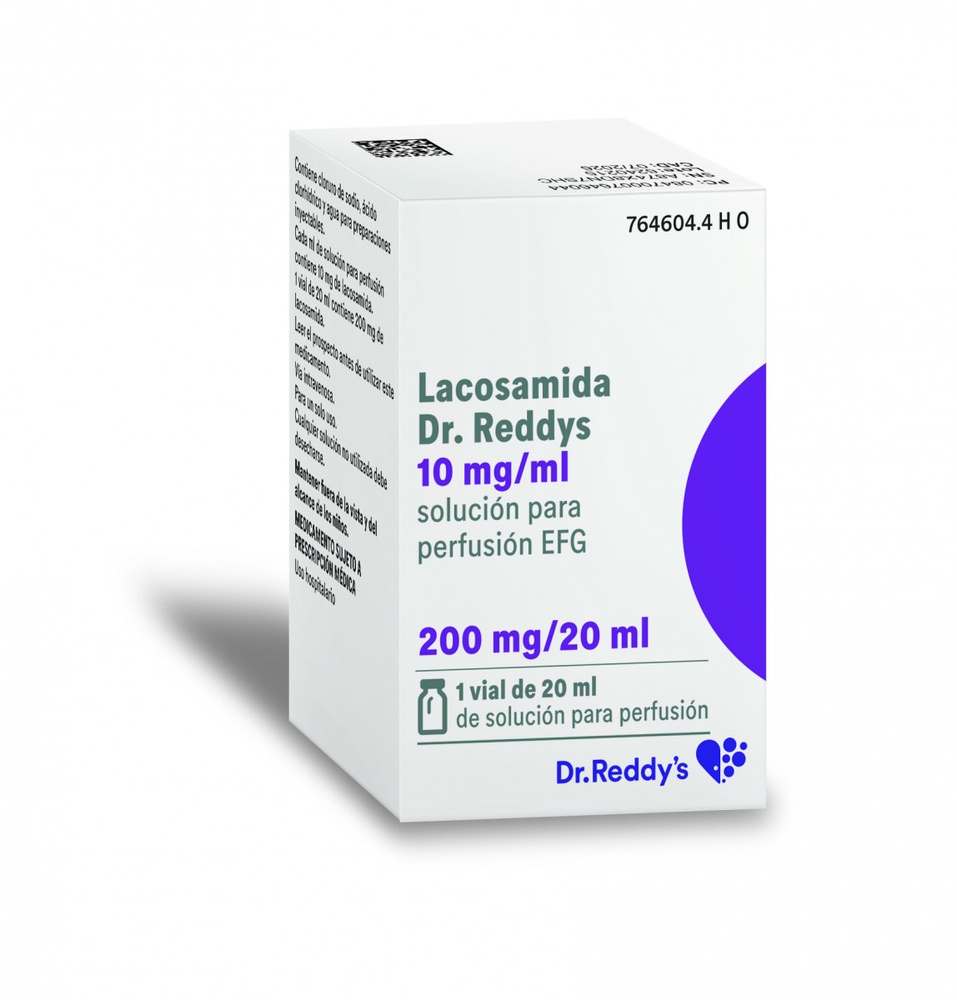

LACOSAMIDA VIVANTA 10 mg/mL SOLUÇÃO PARA PERFUSÃO

Pergunte a um médico sobre a prescrição de LACOSAMIDA VIVANTA 10 mg/mL SOLUÇÃO PARA PERFUSÃO

Como usar LACOSAMIDA VIVANTA 10 mg/mL SOLUÇÃO PARA PERFUSÃO
Introdução
Prospecto: informação para o paciente
Lacosamida Vivanta 10 mg/ml solução para perfusão EFG
Leia todo o prospecto detenidamente antes de começar a usar este medicamento, porque contém informações importantes para si.
? Conserve este prospecto, porque pode ter que voltar a lê-lo.
? Se tiver alguma dúvida, consulte o seu médico ou farmacêutico.
? Se experimentar efeitos adversos, consulte o seu médico ou farmacêutico, mesmo que se trate de efeitos adversos que não aparecem neste prospecto. Ver seção 4.
Conteúdo do prospecto
- O que é Lacosamida Vivanta e para que é utilizado
- O que precisa saber antes de começar a usar Lacosamida Vivanta
- Como usar Lacosamida Vivanta
- Posíveis efeitos adversos
- Conservação de Lacosamida Vivanta
- Conteúdo do envase e informações adicionais
1. O que é Lacosamida Vivanta e para que é utilizado
Este medicamento contém lacosamida, que pertence a um grupo de medicamentos chamados
“medicamentos anti-epilépticos”. Estes medicamentos são utilizados para tratar a epilepsia.
- Foi-lhe prescrito este medicamento para reduzir o número de ataques (convulsões) que padece.
Para que é utilizado Lacosamida Vivanta
Lacosamida é utilizado:
- sozinho e junto com outros anti-epilépticos em adultos, adolescentes e crianças a partir de 2 anos de idade para tratar um certo tipo de epilepsia caracterizada pela aparência de crises de início parcial com ou sem generalização secundária. Neste tipo de epilepsia as crises afetam apenas um lado do seu cérebro. No entanto, podem então estender-se a zonas maiores em ambos os lados do seu cérebro;
- junto com outros anti-epilépticos em adultos, adolescentes e crianças a partir de 4 anos de idade para tratar as crises tónico-clônicas generalizadas primárias (crises maiores, com perda do conhecimento) em pacientes com epilepsia generalizada idiopática (tipo de epilepsia que se acredita ter uma origem genética).
2. O que precisa saber antes de começar a tomar Lacosamida Vivanta
Não use Lacosamida Vivanta
- se é alérgico a lacosamida ou a algum dos outros componentes deste medicamento (incluídos na seção 6). Se não tem certeza de que é alérgico, consulte o seu médico.
- se tem um certo tipo de problema do latido do coração chamado bloqueio AV de segundo ou terceiro grau.
Não use lacosamida se algum dos anteriores é aplicável no seu caso. Se não tem certeza, consulte o seu médico ou farmacêutico antes de começar a usar este medicamento.
Advertências e precauções
Consulte o seu médico antes de começar a usar lacosamida se:
- tem pensamentos de autolesão ou suicídio. Um pequeno número de pessoas em tratamento com anti-epilépticos tais como lacosamida tiveram pensamentos de autolesão ou suicídio. Se em qualquer momento tiver este tipo de pensamentos, entre em contato com o seu médico imediatamente.
- tem um problema de coração que afeta o latido cardíaco e, com frequência, o seu pulso é especialmente lento, rápido ou irregular (como um bloqueio AV, fibrilação auricular ou flutter auricular).
- tem uma doença cardíaca grave como insuficiência cardíaca ou teve um infarto de miocárdio.
- se mareia ou se caí frequentemente. Lacosamida pode produzir mareio, o que poderia aumentar o risco de lesões acidentais ou quedas. Isso significa que deve ter cuidado até que esteja acostumado aos efeitos deste medicamento.
Se algum dos anteriores é aplicável no seu caso (ou não tem certeza), consulte o seu médico ou farmacêutico antes de começar a usar lacosamida.
Se está tomando lacosamida, consulte o seu médico se experimentar um novo tipo de crise ou um agravamento das crises existentes.
Se está tomando lacosamida e experimenta sintomas de latido cardíaco anormal (como latido cardíaco lento, rápido ou irregular, palpitações, dispneia (dificuldade para respirar), sensação de mareio, desmaio), consulte com o seu médico imediatamente (ver seção 4).
Crianças
Lacosamida não é recomendado em crianças menores de 2 anos com epilepsia caracterizada pela aparência de crises de início parcial e não é recomendado para crianças menores de 4 anos com crises tónico-clônicas primárias generalizadas. Isso se deve ao fato de que ainda não se sabe se é eficaz e seguro para as crianças deste grupo de idade.
Outros medicamentos e Lacosamida Vivanta
Informa ao seu médico ou farmacêutico se está utilizando ou utilizou recentemente ou poderia ter que utilizar qualquer outro medicamento.
Em particular, informa ao seu médico ou farmacêutico se está tomando algum dos seguintes medicamentos que afetam o coração, pois lacosamida também pode afetar o coração:
- medicamentos para tratar problemas cardíacos;
- medicamentos que podem aumentar o “intervalo PR” em uma prova do coração (ECG ou eletrocardiograma) como os medicamentos para a epilepsia ou a dor chamados carbamazepina, lamotrigina e pregabalina;
- medicamentos usados para tratar certos tipos de arritmia ou insuficiência cardíaca.
Se algum dos anteriores é aplicável no seu caso (ou não tem certeza) fale com o seu médico ou farmacêutico antes de começar a usar lacosamida.
Informa também ao seu médico ou farmacêutico se está tomando algum dos seguintes medicamentos, pois também podem aumentar ou diminuir o efeito de lacosamida no seu organismo:
- os medicamentos para as infecções por fungos como fluconazol, itraconazol e cetoconazol;
- um medicamento para o VIH como ritonavir;
- os medicamentos para as infecções bacterianas como claritromicina e rifampicina;
- uma planta medicinal que se utiliza para tratar a ansiedade e a depressão leves chamada erva de São João.
Se algum dos anteriores é aplicável no seu caso (ou não tem certeza) fale com o seu médico ou farmacêutico antes de começar a usar lacosamida.
Uso de Lacosamida Vivanta com álcool
Como medida de segurança não utilize lacosamida com álcool.
Gravidez e lactação
As mulheres em idade fértil devem falar do uso de anticoncepcionais com o médico.
Se está grávida ou em período de lactação, acredita que possa estar grávida ou tem intenção de ficar grávida, consulte o seu médico ou farmacêutico antes de utilizar este medicamento.
Não se recomenda tomar lacosamida se está grávida, pois não se conhecem os efeitos de lacosamida sobre a gravidez e o feto.
Não se recomenda amamentar um bebê enquanto toma lacosamida, porque lacosamida passa para o leite materno.
Pedir conselho imediatamente ao seu médico se está grávida ou planeia ficar grávida. Ele ajudará a decidir se deve tomar lacosamida ou não.
Não interrompa o tratamento sem falar antes com o seu médico, pois isso poderia aumentar as convulsões (crises). Um agravamento da sua doença também pode danificar o feto.
Condução e uso de máquinas
Não deve conduzir, andar de bicicleta ou usar máquinas até que saiba se este medicamento o afeta. O motivo é que lacosamida pode produzir-lhe mareio ou visão borrosa.
Lacosamida Vivanta contém sódio
Este medicamento contém 60 mg de sódio (componente principal da sal de mesa/para cozinhar) em cada frasco. Isso equivale a 3 % da ingestão diária máxima de sódio recomendada para um adulto.
3. Como tomar Lacosamida Vivanta
Siga exatamente as instruções de administração deste medicamento indicadas pelo seu médico ou farmacêutico. Em caso de dúvida, consulte novamente o seu médico ou farmacêutico.
Uso de Lacosamida Vivanta
- O tratamento com lacosamida pode iniciar-se:
- tomando o medicamento via oral ou bem
- administrado em forma de perfusão intravenosa (o que às vezes se denomina perfusão IV) com a qual o médico ou a enfermeira lhe administra o medicamento em uma veia. A administração dura de 15 a 60 minutos.
- A perfusão IV normalmente é utilizada durante um período curto de tempo, quando o medicamento não pode ser tomado por via oral.
- Seu médico decidirá durante quantos dias lhe serão administradas perfusões. Tem-se experiência da administração de perfusões de lacosamida duas vezes ao dia durante até 5 dias. Para um tratamento a mais longo prazo estão disponíveis lacosamida comprimidos e xarope.
Quando mudar a perfusão para começar a tomar o medicamento por via oral ou vice-versa, a quantidade total que tomará ao dia e a frequência da tomada seguirão sendo as mesmas.
- Utilize lacosamida duas vezes ao dia (com um intervalo de aproximadamente 12 horas).
- Tente utilizá-lo mais ou menos à mesma hora todos os dias.
Que quantidade usar
A seguir são enumeradas as doses normais recomendadas de lacosamida para diferentes grupos de idade e pesos. Seu médico poderia prescrever-lhe uma dose diferente se tiver problemas de rins ou de fígado.
Adolescentes e crianças que pesam 50 kg ou mais e adultos
Quando use lacosamida sozinho:
- A dose de início habitual é de 50 mg duas vezes ao dia.
- O tratamento com lacosamida também pode começar com uma dose de 100 mg de lacosamida duas vezes ao dia.
- Seu médico pode incrementar a dose que toma duas vezes ao dia em 50 mg cada semana, até que alcance uma dose de manutenção entre 100 mg e 300 mg duas vezes ao dia.
Quando use lacosamida com outros medicamentos anti-epilépticos:
- A dose de início habitual é de 50 mg duas vezes ao dia.
- Seu médico pode incrementar a dose que toma duas vezes ao dia em 50 mg cada semana, até que alcance uma dose de manutenção entre 100 mg e 200 mg duas vezes ao dia.
- Se pesa 50 kg ou mais, seu médico pode decidir começar o tratamento de lacosamida com uma única dose “de carga” de 200 mg. Em seguida, começará a tomar sua dose de manutenção contínua 12 horas mais tarde.
Crianças e adolescentes que pesam menos de 50 kg
- No tratamento das crises de início parcial:observe que lacosamida não é recomendado para crianças menores de 2 anos de idade.
- No tratamento das crises tónico-clônicas generalizadas primárias:observe que lacosamida não é recomendado para crianças menores de 4 anos de idade.
Quando use lacosamida sozinho
- Seu médico decidirá a dose de lacosamida de acordo com seu peso corporal.
- A dose de início habitual é de 1 mg (0,1 ml) por quilograma (kg), duas vezes ao dia.
- Seu médico pode incrementar a dose que toma duas vezes ao dia em 1 mg (0,1 ml) por cada kg de peso corporal, cada semana, até que alcance a dose de manutenção.
- A seguir são mostradas as tabelas de dosificação com a dose máxima recomendada.
- Estas doses são meramente informativas. Seu médico calculará qual é a dose correta para você.
A usar duas vezes ao dia,para crianças a partir de 2 anos de idade que pesam de 10 kg a menos de 40 kg
Peso | Semana 1 Dose inicial: 0,1 ml/kg | Semana 2 0,2 ml/kg | Semana 3 0,3 ml/kg | Semana 4 0,4 ml/kg | Semana 5 0,5 ml/kg | Semana 6 Dose máxima recomendada: 0,6 ml/kg |
10 kg | 1 ml | 2 ml | 3 ml | 4 ml | 5 ml | 6 ml |
15 kg | 1,5 ml | 3 ml | 4,5 ml | 6 ml | 7,5 ml | 9 ml |
20 kg | 2 ml | 4 ml | 6 ml | 8 ml | 10 ml | 12 ml |
25 kg | 2,5 ml | 5 ml | 7,5 ml | 10 ml | 12,5 ml | 15 ml |
30 kg | 3 ml | 6 ml | 9 ml | 12 ml | 15 ml | 18 ml |
35 kg | 3,5 ml | 7 ml | 10,5 ml | 14 ml | 17,5 ml | 21 ml |
A usar duas vezes ao dia, para adolescentes e crianças que pesam de 40 kg a menos de 50 kg:
Peso | Semana 1 Dose de início: 0,1 ml/kg | Semana 2 0,2 ml/kg | Semana 3 0,3 ml/kg | Semana 4 0,4 ml/kg | Semana 5 Dose máxima recomendada: 0,5 ml/kg |
40 kg | 4 ml | 8 ml | 12 ml | 16 ml | 20 ml |
45 kg | 4,5 ml | 9 ml | 13,5 ml | 18 ml | 22,5 ml |
Quando use lacosamida com outros medicamentos anti-epilépticos
- Seu médico decidirá a dose de lacosamida de acordo com seu peso corporal.
- Para as crianças e adolescentes que pesam de 10 kg a menos de 50 kg, a dose inicial habitual é de 1 mg (0,1 ml), por cada quilograma (kg) de peso corporal, duas vezes ao dia.
- Seu médico pode incrementar a dose que toma duas vezes ao dia cada semana em 1 mg (0,1 ml) por cada kg de peso corporal, até que alcance a dose de manutenção.
- A seguir são mostradas as tabelas de dosificação com a dose máxima recomendada.
- Estas doses são meramente informativas. Seu médico calculará qual é a dose correta para você.
A usar duas vezes ao dia,para crianças a partir de 2 anos de idade que pesam de 10 kg a menos de 20 kg
Peso | Semana 1 Dose inicial: 0,1 ml/kg | Semana 2 0,2 ml/kg | Semana 3 0,3 ml/kg | Semana 4 0,4 ml/kg | Semana 5 0,5 ml/kg | Semana 6 Dose máxima recomendada: 0,6 ml/kg |
10 kg | 1 ml | 2 ml | 3 ml | 4 ml | 5 ml | 6 ml |
15 kg | 1,5 ml | 3 ml | 4,5 ml | 6 ml | 7,5 ml | 9 ml |
A usar duas vezes ao dia, para adolescentes e crianças que pesam de 20 kg a menos de 30 kg:
Peso | Semana 1 Dose de início: 0,1 ml/kg | Semana 2 0,2 ml/kg | Semana 3 0,3 ml/kg | Semana 4 0,4 ml/kg | Semana 5 Dose máxima recomendada: 0,5 ml/kg |
20 kg | 2 ml | 4 ml | 6 ml | 8 ml | 10 ml |
25 kg | 2,5 ml | 5 ml | 7,5 ml | 10 ml | 12,5 ml |
A usar duas vezes ao dia,para adolescentes e crianças que pesam de 30 kg a menos de 50 kg
Peso | Semana 1 Dose de início: 0,1 ml/kg | Semana 2 0,2 ml/kg | Semana 3 0,3 ml/kg | Semana 4 Dose máxima recomendada: 0,4 ml/kg |
30 kg | 3 ml | 6 ml | 9 ml | 12 ml |
35 kg | 3,5 ml | 7 ml | 10,5 ml | 14 ml |
40 kg | 4 ml | 8 ml | 12 ml | 16 ml |
45 kg | 4,5 ml | 9 ml | 13,5 ml | 18 ml |
Se interromper o tratamento com Lacosamida Vivanta
Se seu médico decidir interromper seu tratamento com lacosamida, ele diminuirá a dose passo a passo. Isso é para evitar que a epilepsia apareça novamente ou piore.
Se tiver qualquer outra dúvida sobre o uso deste produto, pergunte ao seu médico ou farmacêutico.
4. Possíveis efeitos adversos
Tal como todos os medicamentos, este medicamento pode produzir efeitos adversos, embora nem todas as pessoas os sofram.
Os efeitos adversos no sistema nervoso, como tontura, podem ser maiores após uma única dose
“de carga”.
Informar ao seu médico ou farmacêutico se lhe ocorrer algum dos seguintes efeitos:
Muito frequentes:podem afetar mais de 1 de cada 10 doentes
- Dor de cabeça;
- Sentir-se tonto ou nauseado (náuseas);
- Visão dupla (diplopia).
Frequentes:podem afetar até 1 de cada 10 doentes
- Sacudidas breves de um músculo ou grupo de músculos (crises mioclônicas);
- Dificuldade para coordenar os movimentos ou para andar;
- Problemas para manter o equilíbrio, agitação (tremor), formigamento (parestesia) ou espasmos musculares, cair com facilidade e apresentar hematomas;
- Problemas de memória, dificuldade para pensar ou encontrar as palavras, confusão;
- Movimentos rápidos e incontrolados dos olhos (nistagmo), visão borrada;
- Sensação de tontura (vertigem), sensação de embriaguez;
- Estar nauseado (vômitos), secura bucal, constipação, dispepsia, gases excessivos no estômago ou no intestino, diarreia;
- Diminuição da sensibilidade, dificuldade para articular palavras, distúrbio da atenção;
- Ruído nos ouvidos como zumbido ou silbido;
- Irritabilidade, problemas para dormir, depressão;
- Sonolência, cansaço ou fraqueza (astenia);
- Coceira, erupção.
Pouco frequentes:podem afetar até 1 de cada 100 doentes
- Diminuição da frequência cardíaca, palpitações, pulso irregular ou outros cambios na atividade elétrica do coração (distúrbio de condução);
- Sensação exagerada de bem-estar, ver e/ou ouvir coisas que não são reais;
- Reação alérgica à tomada do medicamento, habones;
- Os exames de sangue podem mostrar anormalidades da função hepática, dano hepático;
- Pensamentos de autolesão ou suicídio ou tentativa de suicídio: informar ao seu médico imediatamente;
- Sentir-se enfadado ou agitado;
- Pensamentos anormais e/ou perda da sensação de realidade;
- Reações alérgicas graves, que provocam inchaço do rosto, garganta, mãos, pés, tornozelos ou das zonas baixas das pernas;
- Desmaio;
- Movimentos involuntários anormais (discinesia).
Frequência desconhecida:não pode ser estimada a partir dos dados disponíveis
- Latido cardíaco anormalmente rápido (taquiarritmia ventricular);
- Dor de garganta, temperatura elevada e apresentar infecções com maior frequência do que o normal. Os exames de sangue podem mostrar uma diminuição grave de uma classe específica de glóbulos brancos (agranulocitose);
- Reação cutânea grave, que pode incluir temperatura elevada e outros sintomas pseudogripais, sarpullido no rosto, sarpullido generalizado com inflamação ganglionar (ganglios linfáticos aumentados). Os exames de sangue podem mostrar um aumento dos níveis de enzimas hepáticas e de um tipo de glóbulos brancos (eosinofilia);
- Uma erupção generalizada com bolhas e descamação da pele, especialmente ao redor da boca, nariz, olhos e genitais (síndrome de Stevens-Johnson) e uma forma mais grave que causa descamação da pele em mais de 30% da superfície corporal (necrólise epidérmica tóxica);
- Convulsões.
Outros efeitos adversos da administração intravenosa
Podem ocorrer reações adversas locais.
Frequentes:podem afetar até 1 de cada 10 doentes
- Dor ou desconforto no local da injeção ou irritação.
Pouco frequentes:podem afetar até 1 de cada 100 doentes
- Verdade no local da injeção.
Outros efeitos adversos em crianças
Os efeitos adversos adicionais observados em crianças foram febre (pirexia), moqueo nasal (nasofaringite), dor de garganta (faringite), comer menos do que o habitual (diminuição do apetite), mudanças de comportamento, não agir como normalmente (comportamento anormal) e falta de energia (letargia). A sensação de sono (sonolência) é um efeito secundário muito frequente em crianças e pode afetar mais de 1 de cada 10 crianças.
Comunicação de efeitos adversos
Se experimentar qualquer tipo de efeito adverso, consulte o seu médico, farmacêutico ou enfermeiro, mesmo que se trate de possíveis efeitos adversos que não aparecem neste prospecto. Também pode comunicá-los diretamente através do Sistema Español de Farmacovigilância de Medicamentos de Uso Humano: https://www.notificaram.es. Mediante a comunicação de efeitos adversos, você pode contribuir para fornecer mais informações sobre a segurança deste medicamento.
5. Conservação de Lacosamida Vivanta
Mantenha este medicamento fora da vista e do alcance das crianças.
Não utilize este medicamento após a data de validade que aparece na caixa e no frasco após CAD. A data de validade é o último dia do mês que se indica.
Este medicamento não requer condições especiais de conservação.
Cada frasco de Lacosamida Vivanta solução para perfusão deve ser utilizado uma única vez (um único uso). A solução não utilizada deve ser descartada.
Somente devem ser utilizadas as soluções claras, livres de partículas e sem alteração de cor.
Os medicamentos não devem ser jogados nos deságues ou na lixeira. Pergunte ao seu farmacêutico como se livrar dos recipientes e dos medicamentos que já não precisa. Dessa forma, você ajudará a proteger o meio ambiente.
6. Conteúdo do envase e informação adicional
Composição de Lacosamida Vivanta
- O princípio ativo é lacosamida.
1 ml de solução para perfusão contém 10 mg de lacosamida.
1 frasco contém 20 ml de solução para perfusão, equivalente a 200 mg de lacosamida.
- Os demais componentes são: cloreto de sódio, ácido clorídrico 0,36% (para ajustar o pH), água para preparações injetáveis.
Aspecto do produto e conteúdo do envase
Lacosamida Vivanta 10 mg/ml solução para perfusão é uma solução transparente e incolor.
Lacosamida Vivanta solução para perfusão está disponível em envases de 1 frasco e 5 frascos. Cada frasco contém 20 ml.
Pode ser que apenas alguns tamanhos de envases sejam comercializados.
Título da autorização de comercialização
Vivanta Generics s.r.o.
Trtinová 260/1, Cakovice
196 00 Praga 9,
República Checa
Responsável pela fabricação
Pharmadox Healthcare Limited
KW20A Kordin Industrial Park, Paola, PLA3000, Malta
Ó
MSN Labs Europe Limited
KW20A Corradino Park, Paola, PLA3000, Malta
Pode solicitar mais informações sobre este medicamento dirigindo-se ao representante local do título da autorização de comercialização:
Representante Local:
Vivanta Generics s.r.o. sucursal em Espanha
C/Guzmán el Bueno, 133, edifício Britannia
28003 Madrid
Este medicamento está autorizado nos estados membros do Espaço Económico Europeu com os seguintes nomes:
Alemanha: Lacosamid Vivanta 10 mg/ml Infusionslösung
Espanha: Lacosamida Vivanta 10 mg/ml solução para perfusão EFG
Países Baixos: Lacosamide Vivanta 10 mg/ml, oplossing voor infusie
França: Lacosamide Vivanta 10 mg/ml solution pour perfusion
Itália: Lacosamide Vivanta
Noruega: Lacosamide Vivanta
Dinamarca: Lacosamide “Vivanta”
Finlândia: Lacosamide Vivanta 10 mg/ml infusioneeste, liuos
Suécia: Lacosamide Vivanta 10 mg/ml infusionsvätska, lösning
Data da última revisão deste prospecto:Junho 2023
A informação detalhada deste medicamento está disponível na página Web da Agência Española de Medicamentos y Productos Sanitarios (AEMPS) http://www.aemps.gob.es/
Esta informação está destinada unicamente a médicos ou profissionais do setor sanitário:
Cada frasco de Lacosamida Vivanta solução para perfusão deve ser utilizado apenas uma vez (um único uso). A solução não utilizada deve ser descartada (ver seção 3).
Lacosamida Vivanta solução para perfusão pode ser administrada sem diluição adicional, ou pode ser diluída com as seguintes soluções: cloreto de sódio 9 mg/ml (0,9%), glicose 50 mg/ml (5%) ou solução Ringer lactato.
Desde um ponto de vista microbiológico, o medicamento deve ser utilizado imediatamente. Se não for utilizado imediatamente, os tempos de armazenamento em uso e as condições prévias ao seu uso são responsabilidade do usuário e não devem ser superiores a 24 horas a uma temperatura de entre 2 a 8 ºC, a menos que a diluição tenha ocorrido em condições controladas e assépticas validadas.
A estabilidade em uso química e física foi demonstrada durante 24 horas a temperaturas de até 25 ºC para medicamentos misturados com estes diluentes e armazenados em vidro ou bolsas de PVC.
- País de registo
- Substância ativa
- Requer receita médicaSim
- Fabricante
- Esta informação é apenas para referência e não constitui aconselhamento médico. Consulte sempre um médico antes de tomar qualquer medicamento. A Oladoctor não se responsabiliza por decisões médicas baseadas neste conteúdo.
- Alternativas a LACOSAMIDA VIVANTA 10 mg/mL SOLUÇÃO PARA PERFUSÃOForma farmacêutica: COMPRIMIDO, 100 mgSubstância ativa: lacosamideFabricante: Intas Third Party Sales 2005 S.L.Requer receita médicaForma farmacêutica: COMPRIMIDO, 150 mgSubstância ativa: lacosamideFabricante: Intas Third Party Sales 2005 S.L.Requer receita médicaForma farmacêutica: COMPRIMIDO, 200 mgSubstância ativa: lacosamideFabricante: Intas Third Party Sales 2005 S.L.Requer receita médica
Alternativas a LACOSAMIDA VIVANTA 10 mg/mL SOLUÇÃO PARA PERFUSÃO noutros países
As melhores alternativas com o mesmo princípio ativo e efeito terapêutico.
Alternativa a LACOSAMIDA VIVANTA 10 mg/mL SOLUÇÃO PARA PERFUSÃO em Polónia
Alternativa a LACOSAMIDA VIVANTA 10 mg/mL SOLUÇÃO PARA PERFUSÃO em Ukraine
Médicos online para LACOSAMIDA VIVANTA 10 mg/mL SOLUÇÃO PARA PERFUSÃO
Avaliação de posologia, efeitos secundários, interações, contraindicações e renovação da receita de LACOSAMIDA VIVANTA 10 mg/mL SOLUÇÃO PARA PERFUSÃO – sujeita a avaliação médica e regras locais.







